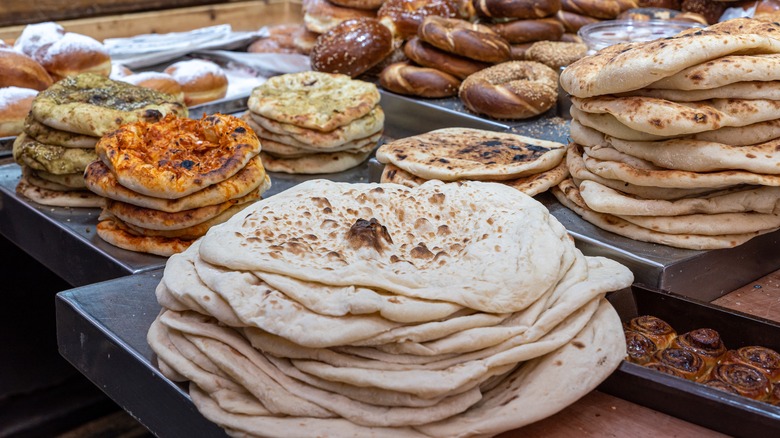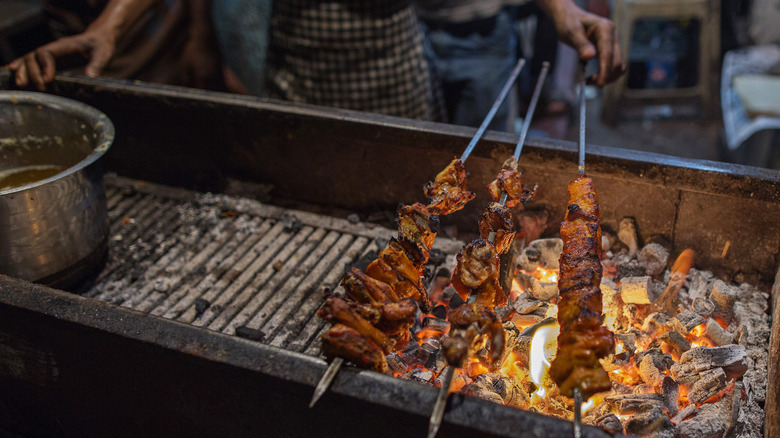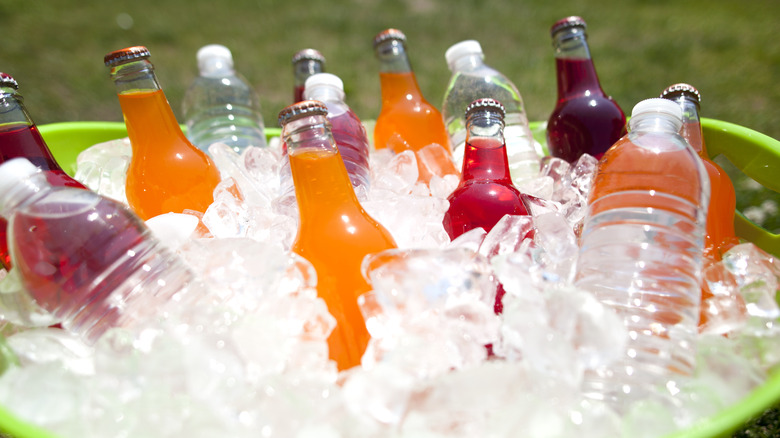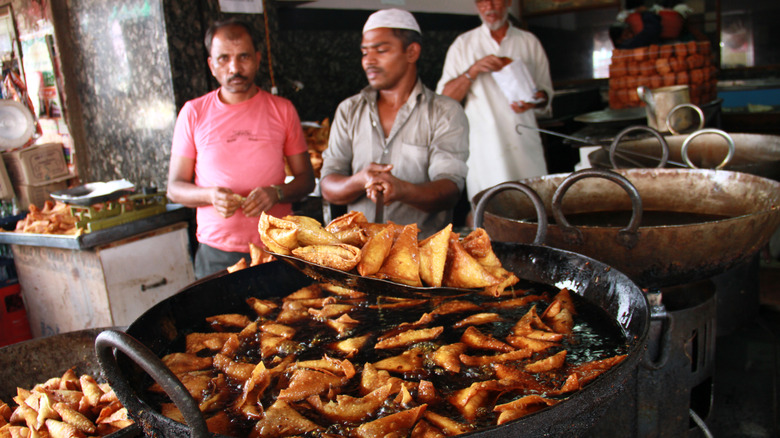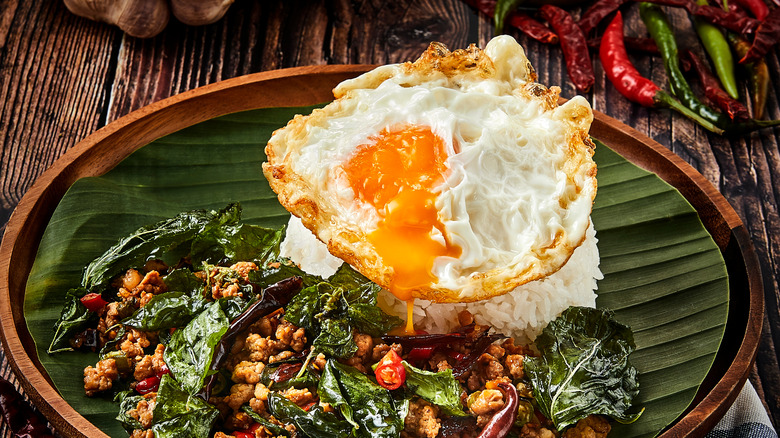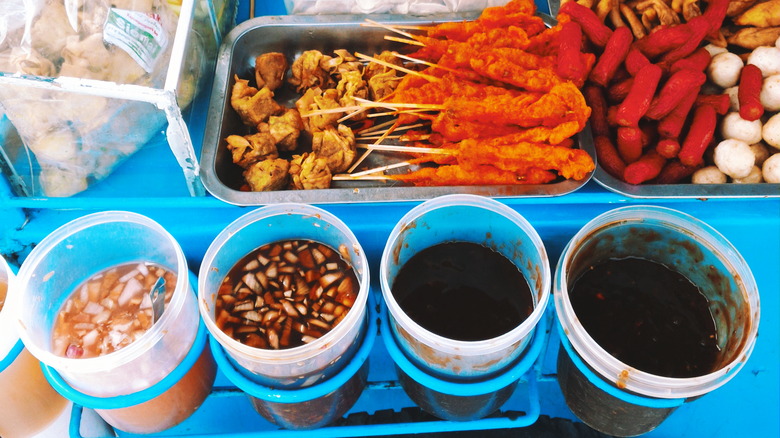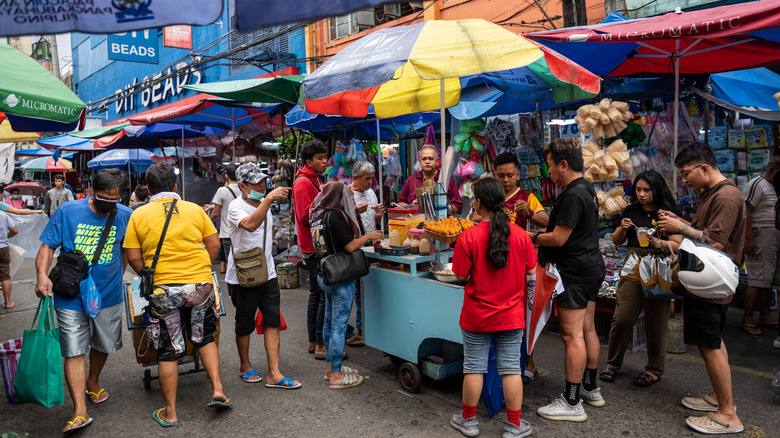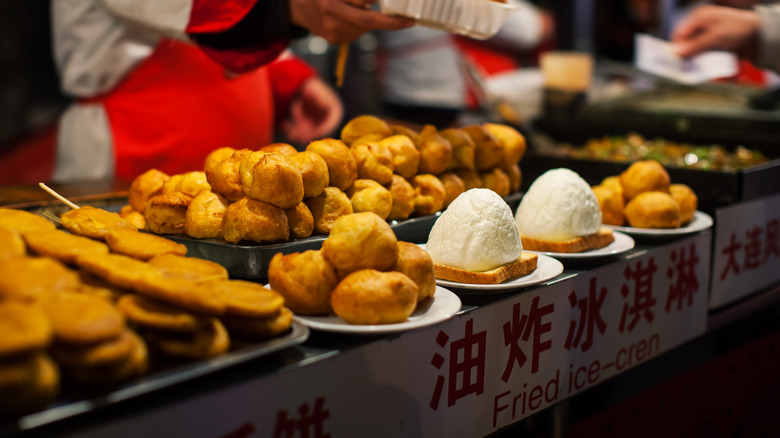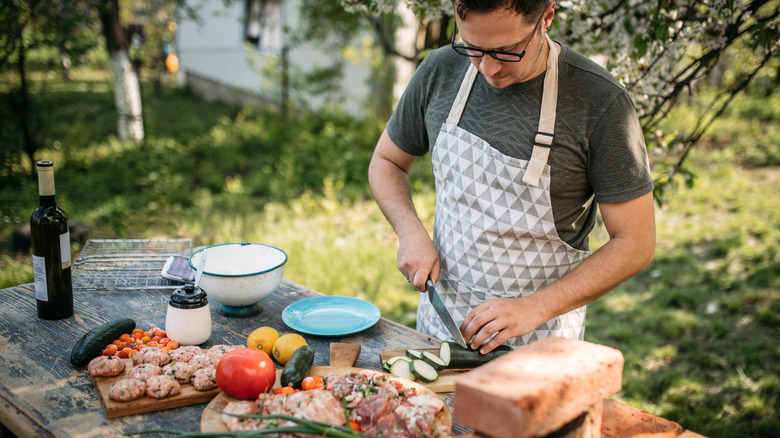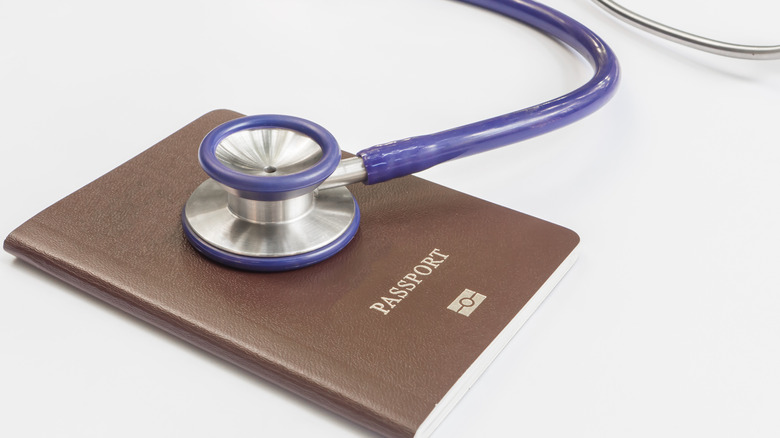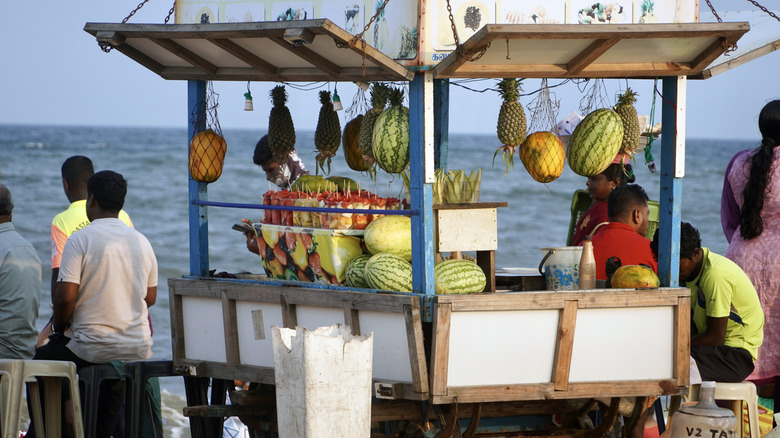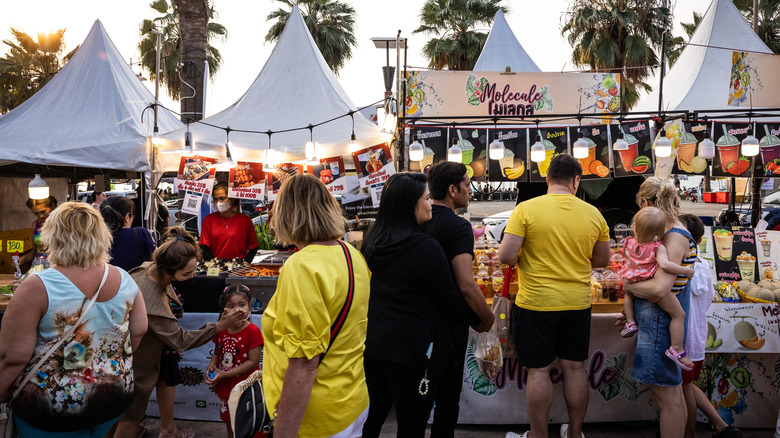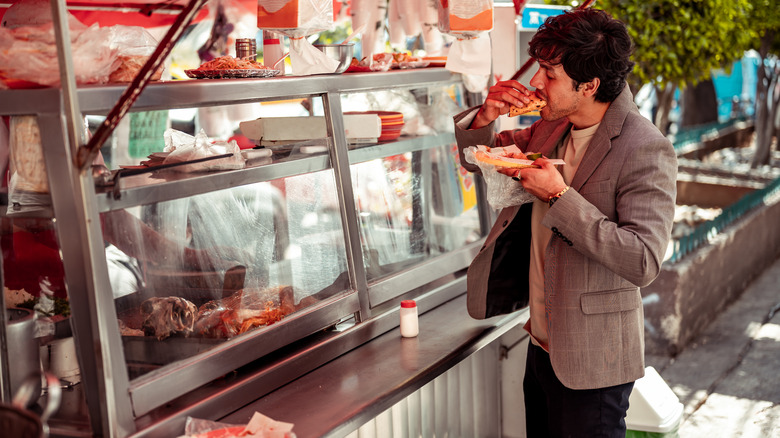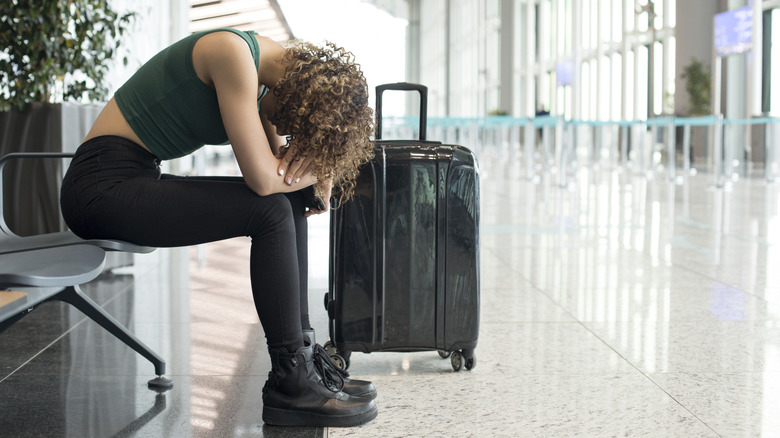Tips And Tricks For Eating Street Food Without Getting Sick
Whether you're keen on trying the food truck that started parking near your office, you're excited about sampling the food carts at the local fair, or you're about to take a trip to Asia, and you want to test-drive a few of the treats offered by street vendors, food safety has likely crossed your mind. While street food vendors may not all be held to the same rigorous food safety standards as brick-and-mortar restaurants in the United States (particularly if you're traveling overseas), that doesn't mean street food isn't safe. In fact, most street food is both delicious and safe to consume.
That said, it's worth exercising caution when you're unsure whether food vendors follow guidelines regarding refrigeration, food handling, or proper cooking temperatures. While there's never a complete guarantee you'll be able to eat at a restaurant (street food or otherwise) without picking up a foodborne illness, there are steps you can take to reduce your risk of getting sick.
Enjoy your grains and baked goods
Don't be shy about grabbing a donut, freshly cooked naan, or a loaf of bread from the person selling baked goods on the corner. This is because grain-based foods are less likely to end up with pathogen contamination that can lead to illness. "Grains are usually dried during storage and handling, so they do not have a high concentration of moisture that can lead to spoilage and contamination, although it is still possible that they may be contaminated with mycotoxins from molds or bacterial spores resistant to the drying process. That said, cooking and baking will help destroy some of those contaminants," says Dr. Bryan Quoc Lee, Ph.D., food scientist and faculty research fellow at Pacific Lutheran University.
In other words, despite some minor risks of contamination to grain-based foods, the baking process largely eliminates the risk, making bread and other baked goods generally safe to consume.
Feel free to eat foods cooked in front of you
When it comes to foods that are cooked on the spot, like stir-fries, kabobs, and even hamburgers, chances are you're in the clear ... that is, if you're paying attention to how the items are prepared. "I recommend opting for foods that are cooked thoroughly and served piping hot," says Melissa Baker, nutritionist and founder of FoodQueries. "Grilled meats, stir-fries, and dishes that are prepared on the spot in front of you often fall into this category. The high heat helps kill off any potential bacteria lurking around."
To that end, Dr. Quoc Le agrees, adding that it's best to steer clear of items intended to be eaten raw, like sushi. "Any food that requires extensive cooking and which was cooked fresh will have a lower load of microbial contamination than food that has been sitting or standing for some period of time or needs to be eaten raw."
Eat your food with bottled beverages
Contaminated water is a common culprit when it comes to food-borne illnesses, particularly when traveling internationally. And while you may know better than to drink out of a water fountain or from the tap, you may not remember that drinks served over ice may also be contaminated, as ice is often made from tap water. "Tap water and ice cubes made from tap water can be potential culprits for stomach woes, so it's generally safer to opt for bottled or filtered water," says Baker.
So when you're craving a nice cold beverage to pair with your street food, skip the fountain drinks or even the smoothies made with ice. Instead, opt for bottled or canned refreshments, and say "no thank you" to any offer of a takeaway cup filled with ice to help keep the drink cold — the added chill simply isn't worth the risk of food poisoning.
Indulge in fried foods and dishes with extra salt, sugar, or alcohol
Just as eating foods cooked in front of you tends to be safer because you can have more confidence that they were brought to a temperature sufficient for killing off bacteria, eating fried foods can be safer, too. This is true even if they aren't cooked in front of you, and even more so if they're foods higher in salt, sugar, or alcohol (donuts, french fries, and beer-battered fish are all good examples).
"Frying at high temperatures will lead to food with much lower moisture and produce food at a higher temperature than other cooking methods, which will help kill off and destroy any contamination. Foods that have a high concentration of salt, alcohol, or sugar, or have been extensively dried, will be less prone to contamination as the combined high concentrations of these ingredients and low water activity creates an environment where there are much fewer pathogens," says Dr. Quoc Le.
Be wary of foods containing eggs, dairy, or meat
While stir-fries and fried chicken may get a pass due to how they're cooked (especially when cooked in front of you), Dr. Quoc Le indicates you should be cautious regarding foods that contain dairy, eggs, and meats, particularly when eating street foods abroad. "Foods containing dairy, eggs, and meats will likely have higher chances of containing food-borne pathogens. Other countries may not have the technology or the regulatory infrastructure to ensure these products are kept free of contamination, especially if they are [consumed] raw, like fresh milk that has not been pasteurized," Quoc Le says.
It's also wise to pay attention to food handling at vendors that sell meats and raw produce. "There is likely to be cross-contamination during the preparation process if a vendor is processing both meats and raw fruits and vegetables, so I would stay clear of these as well," Quock Le adds.
Exercise caution with sauces
Quoc Le is also quick to point out that sauces can be a common culprit of food-borne illness, particularly those that contain dairy, egg, or fish. In addition to the increased risk that ingredients such as these can become cesspools of bacteria, sauces may not be stored properly between uses (allowed to sit out in hot areas without ice or refrigeration), and the moisture content lends itself to bacterial growth.
If the sauces a vendor uses appear to be stored appropriately, or the food items are cooked at a high temperature along with the sauce (like with stir-fries), they may be safer to consume. Just ask the vendor if the sauces contain dairy, egg, or fish, and consider opting out if they do. You can also feel reasonably safe consuming sauces doled out in individually sealed packets (like ketchup, mustard, or soy sauce), particularly if they're being stored in a refrigerator.
Hit the street vendors earlier in the day
One thing to remember is that the longer foods are left to sit out, the more time they have to develop bacterial or pathogen growth. For food vendors who set up shop in the morning and sell their goods all day, the food could become more problematic as the day stretches on. "Morning is usually a safer time to consume street food as the temperatures will be cooler and the ingredients will not have been standing outside throughout the day, where they are likely to grow large loads of microorganisms," Quoc Le says.
Of course, this will vary based on the vendor. For those who only sell food at night or set up shop later in the day, you likely don't have to worry about the time of day as much. Just do think about how long some of the foods have been sitting out and whether they're being stored correctly while they sit. Uncooked foods and foods that should be kept cold (like dairy products) should remain refrigerated. Likewise, fried foods and foods that are cooked but aren't made to order should be kept hot until they're sold.
Eat when everyone else is eating
Especially if you're unsure about a street vendor's precautions regarding food storage and refrigeration, buying and eating food at the busiest time of day is a better bet. This is because when food is being cooked and sold quickly, it's less likely to sit there, gathering germs, just waiting for someone to buy it. "It's generally advisable to choose street food during busier times of the day. When there's a steady flow of customers, it usually means the food is being prepared and sold quickly, minimizing the chances of food sitting out for too long. Additionally, selecting food from stalls that have a high turnover of ingredients can be a good indicator of freshness and lower the risk of consuming something that has been sitting around for hours," says Baker.
So when you're milling about in the center of a busy food sector of the city, or you're in the midst of a crowd at a fair, choose the most popular food vendors and enjoy their wares — they're likely to be safe.
Pay attention to the use of ice or refrigeration
It's not always easy to scope out a street vendor's setup to see if they have refrigeration or ice on hand. But even a cooler tucked under a table or a small refrigerated cart where ingredients are stored is a good sign that the foods they're using, cooking, and selling are safer when it comes to food-borne illnesses. "If there is no source of ice or refrigeration, that is a sign that the ingredients are more likely to have a contamination issue," says Dr. Quoc Le.
Of course, there may be situations (especially at busy times of day) where a small vendor with a barbecue or grill is buying ingredients from a local grocer and essentially cooking to order. Hence, the ingredients on hand are almost always fresh. But remember, that's likely the exception, not the rule. Vendors with larger setups should have some sort of refrigeration or ice on hand to help ensure ingredients aren't breeding grounds for germs.
Check for food-specific cutting boards
Another thing to try to get a line on while perusing street food options is how the vendors cut and prep their meats, fruits, and veggies. Generally speaking, it's questionable food prep etiquette to do anything that might cross-contaminate uncooked meats with produce that won't be cooked. For instance, any practice that could get chicken juice on the lettuce leaves going into a salad or on top of a sandwich is considered a no-no. There are different ways that this can happen, but cutting boards are a big culprit. "If the vendor is only using one cutting board for cutting both animal products and fruits and vegetables, cross-contamination is very likely here," says Dr. Quoc Le.
So as you're checking out street foods, try to note if there are different cutting boards (and knives) for the different types of foods. And while you're at it, check to see if there's a way for vendors to sanitize their hands after touching raw meats if they're also handling fresh produce.
Look for international food-related outbreaks
Food outbreaks aren't uncommon, regardless of where you live. But if you live in the United States, you'll likely catch wind of local issues while watching the news or checking your notifications. Outbreaks taking place in foreign countries may not be advertised in the same way, so it's important if you'll be traveling to research whether there have been any problems with specific foods or specific food-borne illnesses. On the other hand, if you are traveling to a place within the United States but outside of your local region, use the resources available to check for food-related outbreaks. "The CDC offers a list of current outbreaks to help travelers avoid any potential issues with disease, but it's also good to learn more about any potential local outbreaks that may have occurred," says Dr. Quoc Le.
And if a particular food-related or gastrointestinal illness seems to be prevalent in the area where you plan to travel, Quoc Le says it doesn't hurt to talk to your doctor about getting a prescription for those illnesses before you go on your trip. You may not need to use the prescription, but it's better to be safe and prepared than sorry.
Stick to peeled or cooked fruits and vegetables
While fruits and veggies may typically be considered healthy, they're also a frequent source of foodborne illness. This can be due to poor washing practices or cross-contamination with other foods. It can also be because they're washed in local water sources that may be contaminated. "Fresh or raw fruits and vegetables can be problematic when traveling abroad because it is unclear how they were washed and handled during distribution and transport. If it is likely that the drinking water in the region has been contaminated, that may be a source of contamination," Quoc Le says, adding that you also may not know what pesticides or field contamination the fruits and vegetables came into contact with.
Baker agrees but says you don't need to avoid fresh fruits and vegetables entirely. "It's essential to exercise caution. Make sure to thoroughly wash or peel them yourself using safe water sources. If you're unsure about the safety, you can also opt for fruits with a protective outer layer, like bananas or oranges. By taking these precautions, you can enjoy the goodness of fresh produce without unnecessary risks," she says.
Be careful with raw fish and produce
Any food that's served without being cooked first has the potential to carry more bacteria. But that doesn't mean you have to avoid sushi or fresh smoothie bowls altogether. "Items like raw seafood, unpeeled fruits, and salads can be riskier choices. However, this doesn't mean you should avoid them entirely. If you're in a reputable establishment with high turnover, where the ingredients are fresh, you can still enjoy them with confidence," says Baker.
But stick to those recommendations — check Facebook, TripAdvisor, or Yelp for street vendors with good reviews and who have been in business long enough to develop a solid reputation. Then, ensure you're eating at prime eating times (breakfast, lunch, or dinner) so the turnover rate is high. Eating raw sushi that's been sitting around for hours? Not the best plan. But eating raw sushi that's made when you order it with fresh ingredients that haven't been sitting around all day? You're likely not at risk of getting sick.
Trust your instincts
Never underestimate the power of a gut feeling to help protect your gut from illness. Even if a street vendor's set-up is checking all the boxes in terms of apparent food safety — for instance, it's a popular spot, the turnover is high, there are lots of people enjoying the food, and the location appears to be sticking to good food safety practices — if you receive your order and something about it is giving you second thoughts, lean into your intuition. "Trust your instincts and use your senses," says Baker. "If something looks or smells off, it's best to steer clear."
To that effect, giving your food a good pass with your eyes and nose before you put it in your mouth is not a bad idea. Check to see if the meat has been cooked through (street food is a good time to stick to "well done" meats without any pink showing inside) and if the vegetables appear clean. Then, take a sniff before you take a bite. Pay extra attention to potentially problematic foods like seafood, fresh produce, eggs, and milk products.
Don't eat street food shortly before a flight
Being on a several-hour flight when you're feeling well-rested and healthy isn't exactly a walk in the park. It's cramped, crowded, and the bathroom situation isn't exactly easy to navigate when there are lots of people waiting their turn. Just think about how much worse the situation would be if you came down with food poisoning halfway through your flight. For that reason, it's wise to steer clear of street food the day before you hop on a plane.
"When it comes to street food and air travel, it's a good idea to exercise some caution, especially if your flight is approaching. While street food can be delicious and enticing, it's wise to avoid indulging in any potentially risky food right before your flight. The last thing you want is to experience any discomfort or digestive issues while soaring through the skies. Give your stomach some time to settle before taking off," Baker advises.
Use your own utensils (or disposable ones)
One other thing to consider as you make your street food choices is how the food will be served and eaten. Vendors who dole out disposable cutlery and plates or napkins are likely a better choice than those who give you reusable utensils, plates, and cups. While this may seem like a negligent choice when it comes to sustainability, it's a wise choice when it comes to your gut. This is particularly true if you're traveling abroad in a country that has contaminated water. If you don't know how the vendors are washing and sanitizing the items you use to eat your food, you could end up eating off of something that's been washed with water, which could make you sick.
Instead, make sure you opt for disposable cups, plates, and utensils, or bring your own reusable items. This way, you can control how they're washed after using them and still feel good about making an eco-friendly choice.

